
|
Josh and Joe (I Mean Bryan)
4 March 2006
Contents: Introduction | Station Exterior | Station Interior | Final Episode | Conclusion
Introduction
During the four years that I attended Whitmer High School there was a daily news report run by some of the students. The show was called WTMR, and it could be pretty rough at times, especially in the beginning. Bryan MacAfee and I, the creative souls that we were, began brainstorming on how to improve the news presented to us each day during study hall. Our solution was to drop the whole WTMR concept entirely and start fresh with a newscast presented from a space station in low earth orbit. Our working title quickly became Josh and Joe (I Mean Bryan). That title never changed, so I guess that makes it official. MacAfee designed the titles, featuring "Josh and Joe" written nicely in a fancy script, with "Joe" crossed out and "I Mean Bryan" spelled out beneath in driftwood.
We never got very far into actually producing this show, which would have been ten to fifteen minute segments filmed each day. In retrospect this would have been prohibitively expensive to produce on our penny-poor high school budget. Plus, I could never think of a reasonable explanation for why MacAfee and I would be in class each day and yet also be reporting from a space station, meaning that we would have to shuttle back and forth on a daily basis for the sole purpose of doing a newscast. Of course, it had to be a space station for two reasons: 1) The proximity to various satellites meant that we could provide the best and most recent news possible, and 2) Space stations are really cool.
A bit of pre-production artwork and design was done for this show, most of which I never showed MacAfee or my friends. So my posting this here is the first time anyone but me is seeing some of this stuff. All images link to larger versions.
The Space Station (Exterior)
Initially our setting wasn't a space station, but an actual spaceship capable of leaving orbit at its leisure. At this point the actual setting wasn't that important since we were still working out the kinks. My first design in this direction was only a small part of the vessel: a docking bay. There would be several of these bays extending from the ship on long arms. I didn't actually have a design for the ship yet, and they would never turn up on any subsequent designs, but this was a start.

After that start, I went for the larger whole, and the spaceship that I designed would become very important for me personally. The vessel, which I took to calling Magellan, would become the basis for every single JG Enterprises starship to follow. This was the beginning of a design trend, the ship eventually evolving into the Columbus class starship once it lost the solar panels and the enormous docking ring amidships. The docking ring was a replacement for those earlier docking arms.
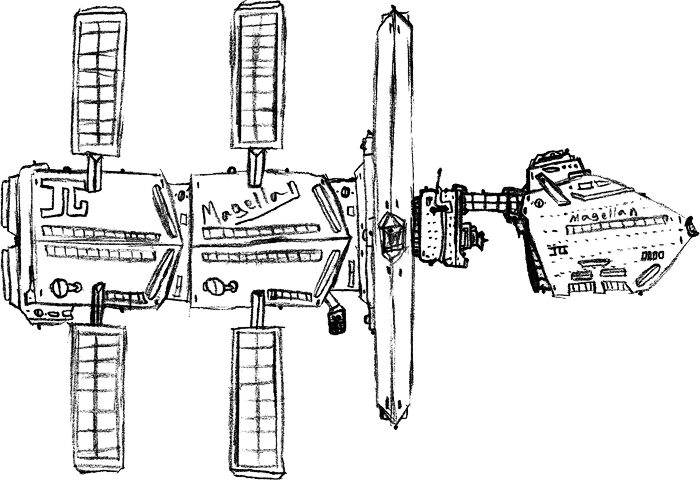
This spaceship design lingered around for a while until I claimed it for the JG Enterprises fleet. At that point the show lost its setting for a couple of years. Work in planning our series was fairly on and off for about three years, the early concepts beginning around late 1996/early 1997 and the final ideas that follow coming in 1999. Our dedication to this project was somewhat underwhelming.
In 1998 the space station was finally decided upon. The following two designs were drawn on 30 January 1999 and were meant to depict a modular station with a dedicated command section in the bow. The cylindrical modules were inspired by parts of the Mir space station, which was still in orbit at the time. The first of these sports a raised aft section, which, with the unintentional "spider eyes" windows on the front, gives it a slight arachnid feeling.

The second station design features a slightly raised command deck borrowed from the original Battlestar Galactica and locates the newsroom in the block aft of center. I still really like the lines on this one, especially with the ventral and dorsal girders, along which more antennas could be mounted. Though more design work followed that deviated from this design, if I were doing this series today, with the hindsight of where we'd gotten in the '90s, this is the station that I'd like to finesse.
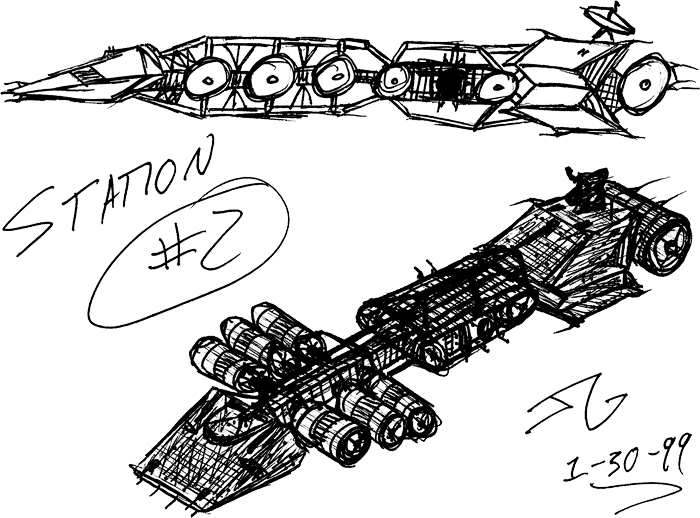
Regardless, two days later I decided that the command module should be capable of atmospheric reentry, so I redesigned it to resemble the nose of the space shuttle, complete with thermal protection tiles, and included similar windows, airlock, and thruster arrangements. I also covered them in various antennas to emphasize the station's purpose as a news center. The detachable command module would serve its purpose in the final episode, of which I'll say more later. The last two of these show the clamps on the rear that held the module to the rest of the station.
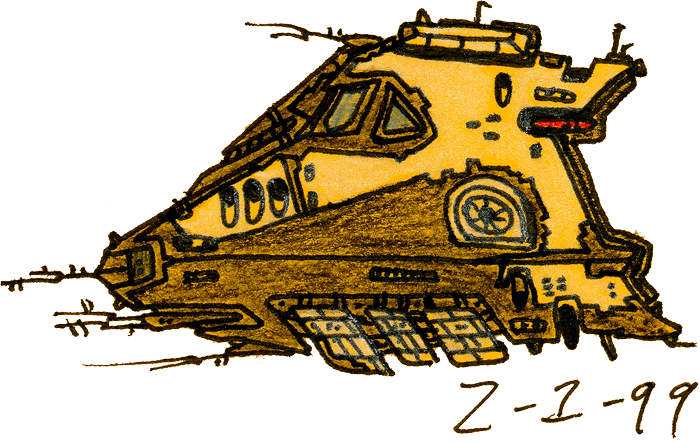

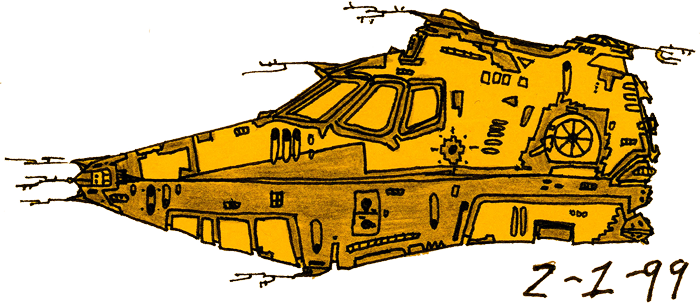
That amounts to all of the work I did on the station's exterior. These were also pretty much the last bit of effort placed into the show before it finally died its protracted death. But let's take a look inside, shall we?
The Space Station (Interior)
The main purpose of the station was to serve as a newsroom in orbit. Therefore, the most important interior set would have been the newsroom itself. Despite the importance of this particular room, very little design work went into it. That might seem like an oversight, but part of the rationale was that only a small part of this room would actually be seen, and its actual proportions would be dictated by the space we found to build it in and by how much would fit on camera. It became a "play-it-by-ear" set, that its actual design would come about as it was being built. Our first piece of design artwork was of this set, and the awesome ones among you will probably see the Mystery Science Theater 3000 design elements thrown in, particularly the three lights above the doors. This was because our earliest thoughts featured a MST3K-style sequence with MacAfee and I commentating on news playing on a large screen, with our shadowed figures at the bottom. Hey, I didn't say that everything we did was original.
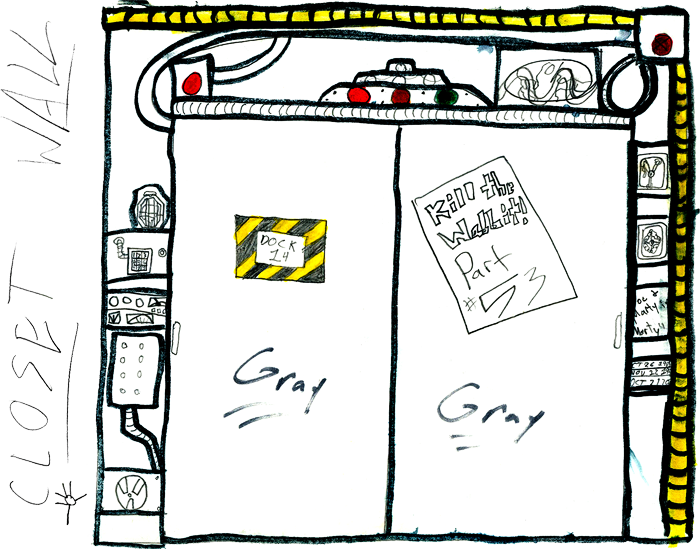
That set would have been built in my bedroom using my closet doors, which would have been paneled in posterboard to cover the wood grain. We even pulled down the posters and stuff that I had hanging on the walls and began building the set. We had painted some boxes silver and even hung the box in the top right corner. The yellow tubes were made from painted toilet paper rolls. That partially built set remained around for a few months before I took it down because it wasn't going anywhere. The "Dock 14" sign remained for years, only coming down in 2010. MacAfee lobbied for the "Kill the Wabbit! Part #53" poster, but I did get the Flux Capacitor, so I guess we were even. I even constructed the MST3K-style theater, with one whole wall in my room given to a screen, and a row of seats in front with a light set up to cast the shadows. We hadn't worked out the mechanics of how to film it and didn't have access to green screen and chroma key software back then. It didn't take long to lose the MST3K ideas, and the doors along with them. A smaller, purpose built set was designed to closer resemble an actual newsroom, but with a few sci-fi flourishes, like the panels on the desk.
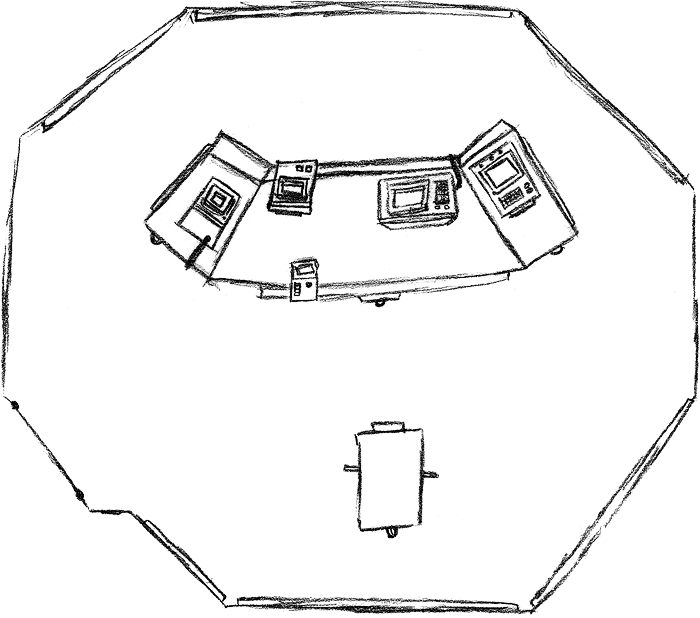
I also did a series of bridge designs. The first just resembled a Star Trek bridge way too much, and I tried to move away from that with subsequent designs. Story wise, I actually needed a set that wasn't the main bridge but rather an auxiliary control room. You see, in the final episode the main bridge was going to be rendered inaccessible, forcing our gallant crew to use the controls in the auxiliary bridge. The following design is closest to what we could have hoped to build, but even then it's way too big and still too Trekish.
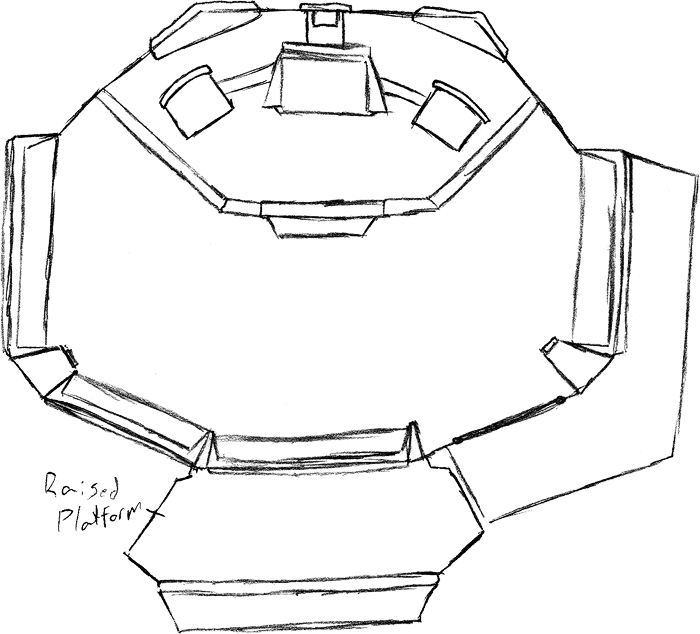
Bear in mind that the show was still set aboard a larger spaceship at that point. When it became the space station the bridge would have been shrunk into a cockpit-like design, with the auxiliary control room being much smaller still, essentially little more than a closet with a control panel and a chair. Of course a chair. The realism of a no-gravity environment was another thing sacrificed to budget if we ever wanted to leave the newsroom.
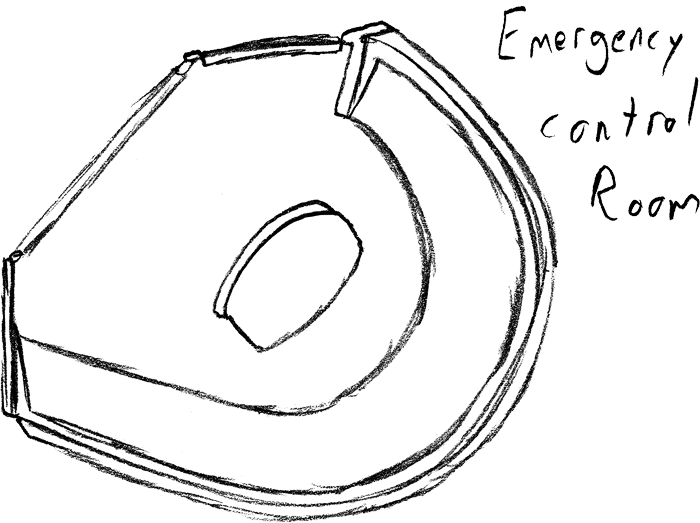
You know, I've brought up the final episode a few times. We should probably talk about it.
The Final Episode
From the start I knew how I wanted to end our run. I wanted the final episode to be a gigantic, pounding, special-effects driven action-packed event. Basically everything I wouldn't have been able to do in a regular episode.
We would have begun with a standard newscast, like it's a normal day. All of a sudden alarms begin clanging and the lighting switches to red. The newscasters are shocked at first, staring blankly at the chaos. It takes a second for them to snap into action, checking monitors, running back and forth trying to confirm the danger. They come to a startling realization at the same time: the station is being boarded by a hostile alien race. Attempts to regain control of the station fail, as the enemy crew outnumbers our own hapless heroes. Weapons fire drives our newscasters through an access panel as they attempt to reach the main bridge, which they quickly come to discover has already been taken by the hostiles. They flee to the auxiliary control room in the original spaceship version.
In the revised space station version the crew return to the newsroom rather than going to auxiliary control. Not only does one of those panels on the desk have to do something, but also building a control room would have been too expensive and time consuming on top of everything else planned for the episode. In the newsroom our crew activates the station's destruct charges. Taking one last look around, they beat a hasty exit for the lifeboat. They manage to get off the station just as the charges begin going off. For the first time we see that the enemy vessel dwarfs the station that it's clinging to, and the two go up in a larger-than-life fireball, our crew being rattled in their escape vehicle by the shockwave as they enter Earth's atmosphere.
The actual escape vehicle was never decided upon. I was trying to design the front of the station to be a detachable command module, as already shown. But that wouldn't have the drama of having the enemy crew in the main control center. Realistically, they would just leave in the capsule they launched on, but I figured there should he a dedicated lifeboat tucked away somewhere. I never designed any escape pods, but I did a bit of work on the enemy ship.
Actually, the enemy ship was tied into a movie project at the time, my impossible opus now known as Down. Since these two were being developed concurrently I figured that alien starship designs not used in one could instead work for the other. In the end, neither ever got made, so I have a bunch of decent alien ship designs in a binder full of spaceship drawings.

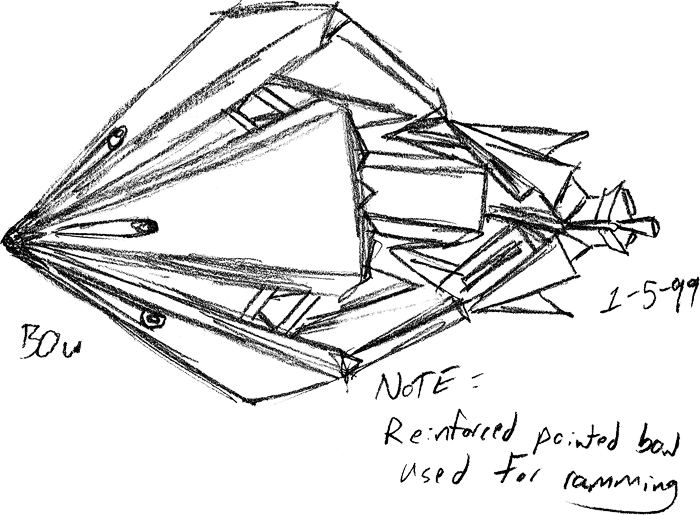
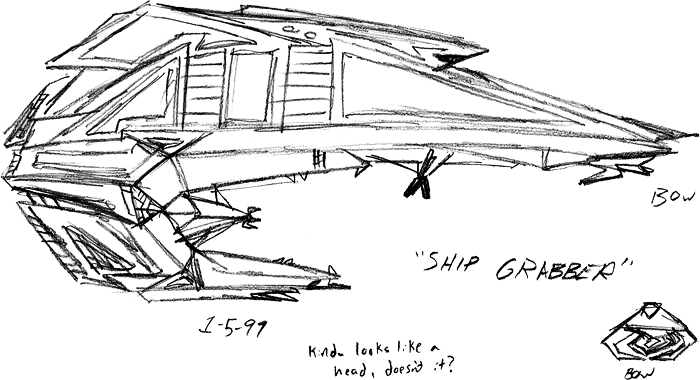
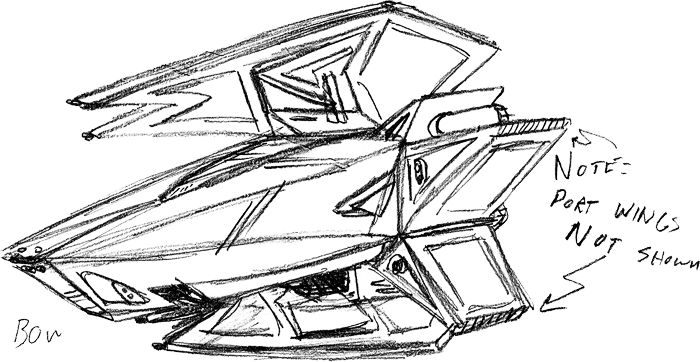
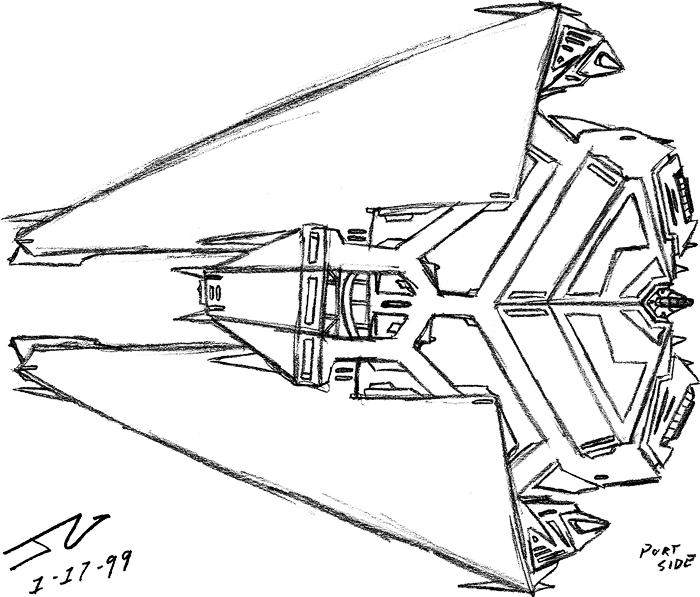
Looking back, I cringe while recalling that plan. Aliens! Explosions! It's all a little too much obnoxiously bad sci-fi for a space station news show. Back then I wanted to go way, way out into left field and tell an absurdly big story. Nowadays, I'd just have a meteorite strike the station to demand its abandonment and play it all straight. I've mellowed since my teenaged days.
Conclusion
I still feel that Josh and Joe (I Mean Bryan) had promise. It would have been ridiculous, but I think that MacAfee and I could have brought our own mixed bag of esotericism to the show. I do have to admit that a strong driving force for me was the prospect of blowing up the model at the end of the series. I'm a real-life spaceflight enthusiast, so making the space station as real as possible was important for me, and I really wanted to show everything: living spaces, sleeping quarters, toilets, airlocks, everything. I wanted to depict as realistic a space station as possible ... even if the exploding space station was more over the top.
This project never saw fruition for a number of reasons. The biggest being an unsustained level of interest. I may have given an impression in this article that a lot of effort was put into the show, but it was spread over more than three years and this article contains about the extent of everything we produced. After the first year MacAfee wasn't even really involved anymore and I was just developing concepts in quiet and not doing anything with them. Second, we simply didn't have the time or budget to pull this off. It would have involved building sets, constructing models, making costume items, and coming up with props. Trying to depict a functioning space station wouldn't have been an easy task at all, and that's not even figuring in the added work on the final episode (aliens, alien ship, pyrotechnics, escape vehicle, possible new sets). Third, I didn't really want the attention. MacAfee and I would likely have wound up being the newscasters, and I didn't want that. I rather liked my anonymity in high school and I didn't think we'd be able to bring enough people on that I wouldn't have to act. Finally, and probably most important, was the crew of WTMR. They did a lot of work on their show and were proud of their efforts. Who were we to criticize their early efforts at making a news program? We began developing this in the first couple months of WTMR, when they were still finding their legs. Their show did improve greatly with age, and it was hugely presumptuous to think we could produce something better, set in space no less.
When I wrote this in 2006, it had been almost ten years since MacAfee and I did that first design using my bedroom as a newsroom. WTMR disappeared for some time, and the program was later restarted by a new class of Whitmer students. I'm pleased to hear that, and wish them the best in their daily newscasting. How much seriousness actually went into Josh and Joe (I Mean Bryan)? It's difficult to say. I mean, we did actually begin building stuff for it, and writing out partial scripts, not to mention all the design work I just showed you. But our hearts weren't completely into it, and the show became, when all was said and done, more of an intellectual exercise into what we could come up with. I remain happy with the stuff I did for this project, even if it took nearly a decade to see the light of day. I hope you enjoyed browsing through these ideas, and hope even more that at some point you thought to yourself, "that could have been kind of cool."
As a parting thought for the twentieth anniversary, here's a 2016 revisit to my favorite of the 1999 station designs. It still needs more antennas.
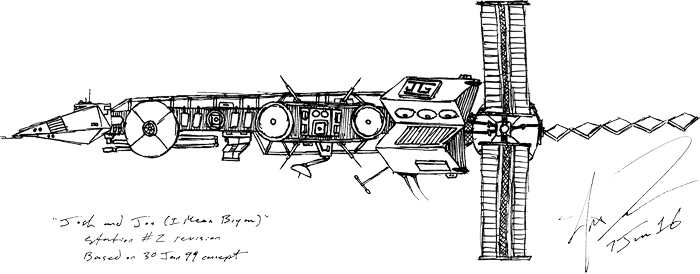
 Articles Articles
|
 |

